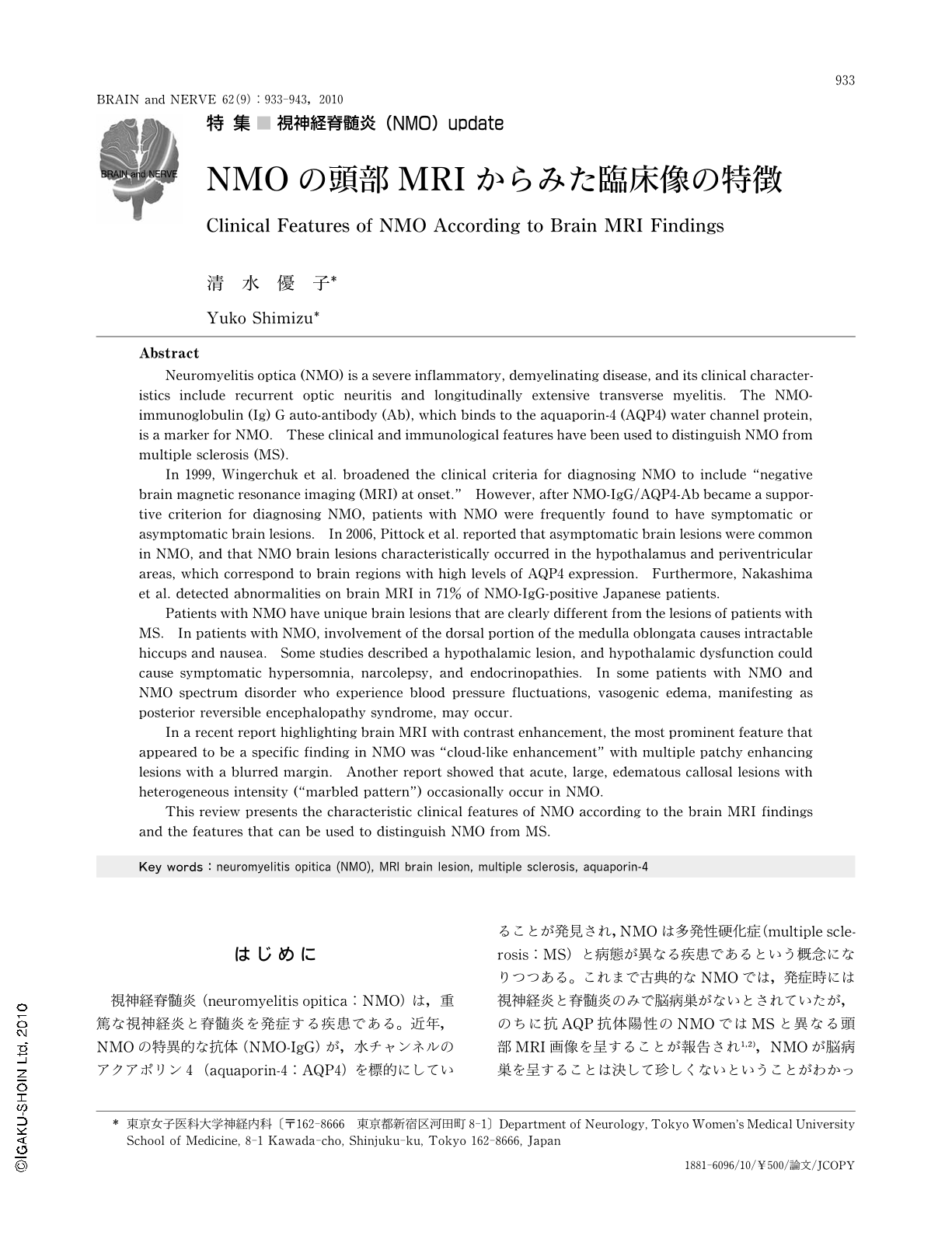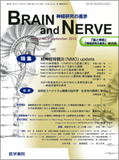Japanese
English
- 有料閲覧
- Abstract 文献概要
- 1ページ目 Look Inside
- 参考文献 Reference
はじめに
視神経脊髄炎(neuromyelitis opitica:NMO)は,重篤な視神経炎と脊髄炎を発症する疾患である。近年,NMOの特異的な抗体(NMO-IgG)が,水チャンネルのアクアポリン4(aquaporin-4:AQP4)を標的にしていることが発見され,NMOは多発性硬化症(multiple sclerosis:MS)と病態が異なる疾患であるという概念になりつつある。これまで古典的なNMOでは,発症時には視神経炎と脊髄炎のみで脳病巣がないとされていたが,のちに抗AQP抗体陽性のNMOではMSと異なる頭部MRI画像を呈することが報告され1,2),NMOが脳病巣を呈することは決して珍しくないということがわかった。MSは脱髄が主体であるが,NMOではastrocyteがその炎症の主座であるという病態の違いから,NMOの頭部MRI画像所見もMSとは異なる。NMOの頭部MRI画像の特徴は,①好発部位はAQP4が豊富に発現している第三脳室,第四脳室,中脳水道の周囲,延髄背内側,中心管,視床下部に多い,②造影増強効果の特徴としてcloud like enhancementを呈する,③左右対称性,広範な病巣をきたすことが多い,という点が挙げられる。臨床症状の特徴は病巣部位を反映して,難治性吃逆,嘔吐,ナルコレプシー,過睡眠,内分泌異常である。本稿では,これまで報告されているNMOの頭部MRIの特徴とMSとの相違,NMOの臨床症状の特徴について述べたい。
Abstract
Neuromyelitis optica (NMO) is a severe inflammatory, demyelinating disease, and its clinical characteristics include recurrent optic neuritis and longitudinally extensive transverse myelitis. The NMO-immunoglobulin (Ig) G auto-antibody (Ab), which binds to the aquaporin-4 (AQP4) water channel protein, is a marker for NMO. These clinical and immunological features have been used to distinguish NMO from multiple sclerosis (MS).
In 1999, Wingerchuk et al. broadened the clinical criteria for diagnosing NMO to include "negative brain magnetic resonance imaging (MRI) at onset." However, after NMO-IgG/AQP4-Ab became a supportive criterion for diagnosing NMO, patients with NMO were frequently found to have symptomatic or asymptomatic brain lesions. In 2006, Pittock et al. reported that asymptomatic brain lesions were common in NMO, and that NMO brain lesions characteristically occurred in the hypothalamus and periventricular areas, which correspond to brain regions with high levels of AQP4 expression. Furthermore, Nakashima et al. detected abnormalities on brain MRI in 71% of NMO-IgG-positive Japanese patients.
Patients with NMO have unique brain lesions that are clearly different from the lesions of patients with MS. In patients with NMO, involvement of the dorsal portion of the medulla oblongata causes intractable hiccups and nausea. Some studies described a hypothalamic lesion, and hypothalamic dysfunction could cause symptomatic hypersomnia, narcolepsy, and endocrinopathies. In some patients with NMO and NMO spectrum disorder who experience blood pressure fluctuations, vasogenic edema, manifesting as posterior reversible encephalopathy syndrome, may occur.
In a recent report highlighting brain MRI with contrast enhancement, the most prominent feature that appeared to be a specific finding in NMO was "cloud-like enhancement" with multiple patchy enhancing lesions with a blurred margin. Another report showed that acute, large, edematous callosal lesions with heterogeneous intensity ("marbled pattern") occasionally occur in NMO.
This review presents the characteristic clinical features of NMO according to the brain MRI findings and the features that can be used to distinguish NMO from MS.

Copyright © 2010, Igaku-Shoin Ltd. All rights reserved.


